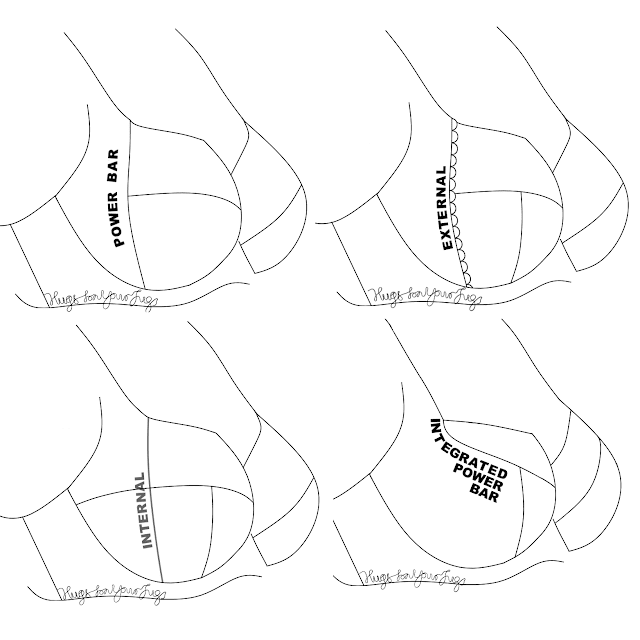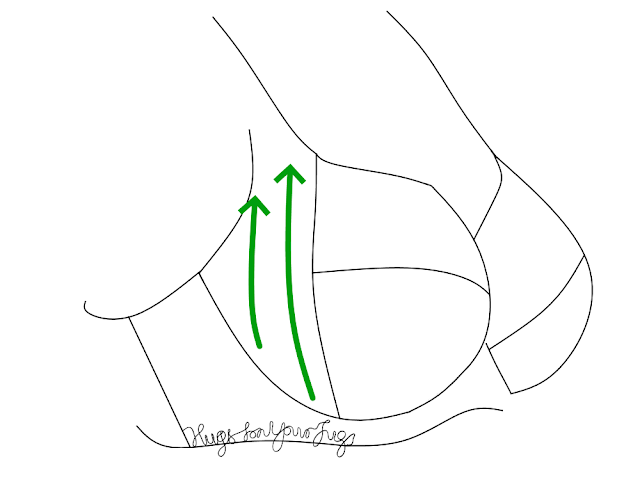Necklines always cutting in? Why full cups may be your foes and power bars your unlikely friends
I have a series of posts about the physics behind supportive bras. In the first post, I described that the band should make up most of the support system of a bra - but this doesn't mean the straps are not important. The best way to boil that post down is that the band provides support to the breasts but the straps maintain the shape of the cups by providing a key anchor point for the upper part of the cups. This post could be considered an additional part of that series, and for that reason an extended edition can be found on my Ko-fi. Don't worry, the main Bra Physics series hasn't been abandoned - I just wanted to get this one out first.
The straps transmit a vertical tension force into your bra cup, and changing exactly where those forces travel can have major fit implications. This force transmission is very important in larger cup sizes where a bra is designed to be more supportive, so the ideas in this post will apply to a lesser degree for small or medium cup sizes, where the overall forces are lower. This post focuses on higher coverage bras but the concepts within can be applied to plunge and half cup bras too
Large cup bras by popular brands often utilise side support in various formats - there's power bars, integrated power bars, external power bars, internal slings. All do their job with varying levels of effectiveness but all have the same job: they are an unrounded area at the side of the bra that gets pulled on directly by the strap, pushing breast tissue forwards and creating a more fashionable silhouette. However, this is not the sole reason why side support systems are so ubiquitous in large cup bras.
Let me explain further:
When a bra strap pulls on fabric, the tension follows some line in the fabric, pulling it taut until it reaches the rigid wire. Because of this, a bra needs to be designed with some intentionally flat/taut areas so you don't end up with an unintentionally lumpy bra.
In a traditional full cup style bra, the neckline of the bra is the flat area, the rest of the cup is rounded. This is achieved by having the neckline be tight, so when it's pulled on by the strap the neckline doesn't stretch out and cause the bra to lose support. Because of this tight neckline, shorter breasts can be encapsulated fully, but on breasts with more upper fullness, centre fullness or taller roots, the bra can cut in. Increasing the height of the bra can help to encapsulate the breast, but this is not always possible (or desired!) with tall or centre full shapes.
Encapsulating these breasts requires either taller wires at the centre front or the straps being moved in drastically (so as to create a more vertical neckline). This is often unfashionable, uncomfortable or is sometimes impossible, depending on the individual.
In a traditional diagonally seamed bra, the wider position of the straps on a diagonally seamed bra and thus the more horizontal angle of the neckline at the centre front (as compared to the angle of the neckline at the armpit) can both help to mitigate this issue, and redirect some force to the side of the cup. However, any fullness in the diagonal seam encourages some strap force to travel down the centre front of the bra, usually making the neckline tight in a similar manner as the full cup.
This can be partially avoided by reducing fullness in the outer cup, however because of the strap still attaching directly to the upper cup piece, this design is still not going to be as good as side support bras for tall and centre full shapes.
In a side support bra, the power bar provides a direct, taut connection to the lower wire. This carries the force from the strap directly downwards, creating tension in this area only, and allows for the neckline to be opened up. The flat spot in this case exists at the side of the cup. This open neckline allows centre full breasts and tall roots the space they need, and can allow for a large cup bra to be more low cut without tension creases in the cups.
There's more to bra shape than just the addition of side support, but if you're struggling with cutting in on the neckline edge, this is the alteration to make.
In the extended edition of this post, I go into the vertical positioning of the straps and how power bars can be used to circumvent fit issues caused by high strap attachment points.
If you liked this post, be sure to follow me for email updates whenever I post a new one! If you really liked this post, donate to my Ko-fi for extra content!






This explains so much! Would an internal powerbar achieve the same result?
ReplyDeleteYes, as shown in the first diagram all types of power bar have this effect, although the extent varies based on other elements of cup design
DeleteHola, e gustaría que explicarás el paso a paso de los patrones,desde el inicio para !legal las últimas explicaciones. Desde ya muchas gracias!
ReplyDeleteVery good article Thanks
ReplyDeleteHELP!!!! I am a 34D sometimes a DD depending on weight fluctuations (why do we always loose it in our breasts first??) but I am small framed and what I call the box of the bra (sorry I don’t know the correct terminology) Basically the front of the bra in between the outsides of the wires, just the cups of the bra Is always to wide and no matter what bra brands or price point it is always too wide. When I pull the two center wires together so they almost start to overlap slightly it is a perfect fit. Please please help me, I am 67 and have pain in my breasts all the time. I have been checked sixteen ways from Sunday and I do not have any breast cancer and I am blessed that my chance of it is a score of .02 based upon family history and 3 D scans as well as ultrasounds. I was a 32 AA until I got pregnant with my son and in 3 months was a 34DD, I also Breast fed my daughter for 13 months which I loved but caused my breasts to be even bigger until I weaned her and left me with the consequences that breast feeding sometimes does. Pain that has no reason. I absolutely love coffee but any caffeine causes increased pain. I am so incredibly tired of spending money on so many sizes, most with underwires which seem to have the best support and give my the best shape of all the brands, types of bras from expensive sports bras to bras that make you have unaboob and everything in between. I have bra’s that are sized from 32C to 36DD and it is incredibly difficult to find 32 D or DD which I think is the best size but then again I just don’t know what the answer is. I have gone to supposedly get professionally sized and they put me in a 36DD but I have since lost 30+ lbs. I need the support for my larger breast size and would love to have side support as well. Or maybe I’m searching for what doesn’t exist….a comfortable pretty, well made bra that doesn’t dig or hurt my rib cage, cause me more pain from digging and make my girls look like they aren’t staring to the side of the room…
ReplyDeleteHi Johnette, please go to the A Bra That Fits subreddit and/or facebook group to get some personalised advice on ready to wear lingerie
DeleteI think your best bet is to try the a bra that fits calculator on the reddit page, get your measurements and go from there. For a 32 D or 32 DD if that is your size, you’ll have better luck looking at UK bras (Freya, Panache, Elomi, Curvy Kate) or even something like Understance. Your UK size would be either 32D or 32E depending on if your estimation is correct. Your pain is definitely caused by too big of a band leading to your bra digging in, and even a too large cup size. Amazon is a great place to find UK brands for a good price. Good luck!
Delete